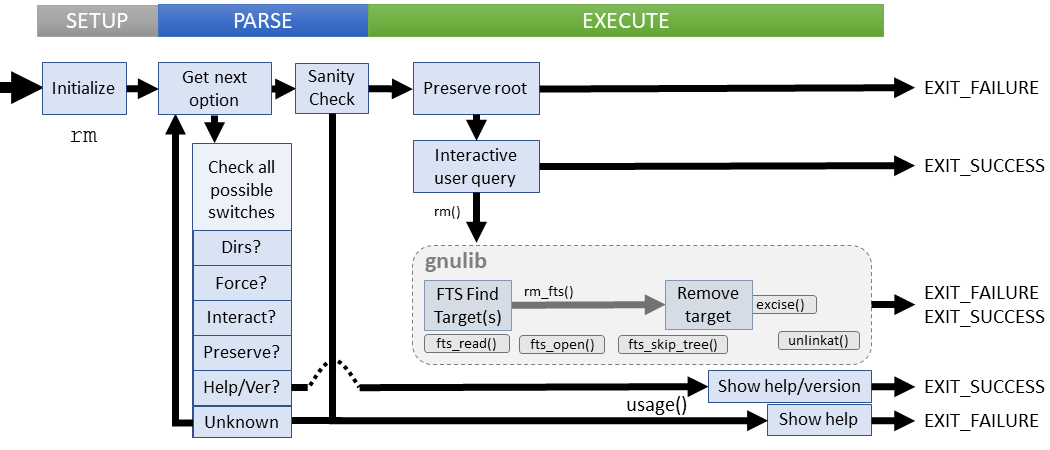[GNU Manual] [POSIX requirement] [Linux man] [FreeBSD man]

Summary
rm - remove files or directories
Lines of code: 374
Principal syscall: unlinkat() via gnulib FTS
Support syscalls: None
Options: 19 (7 short, 11 long)
Descended from rm introduced in Version 1 UNIX (1971)
Added to Fileutils in October 1992 [First version]
Number of revisions: 194
The rm utility seems deceptively simple because most of the work is pushed to gnulib, including the fts interface.
Helpers:diagnose_leading_hyphen()- Verifies command line input consistency (files might begin with '-')rm_option_init()- Initializes anrm_optionsstruct
die()- Exit with mandatory non-zero error and message to stderrerror()- Outputs error message to standard error with possible process terminationngettext()- Processes text for native language support. (from gnulib adapted from the gettext in the GNU Translation Projectpriv_set_remove_linkdir()- Remove ability to unlink directories (from gnulib)rm()- Wrapped for removing a target using fts
Setup
rm uses several global enums to set behavior options. The most notable is interactive_type, which matches three type values to argments in interactive_types. The values are user responses to handling multiple matches such as 'never', 'once', or 'always' take an action.
main() defines four variables:
c- The first character of the next option to processpreserve_root- Flag if the utility should preserve rootprompt_once- Flag to ask the user for a decision one timerm_options- Struct to hold options for rm (in remove.h)
Parsing
Parsing for rm needs at least one target. The options answer a list of questions about how to handle the targets.
- Are we preserving root?
- Are we operating recursively
- Should we query the user for handling mulitple matches?
- Should we ignore most problems and continue processing?
- Only target one file system?
Parsing failures
These failure case is explicitly checked:
- No target file provided
- Unable to find root inode
- Unknown option is used
Failure results in a short error message followed by the usage instructions.
Execution
Very little work is performed directly in rm setting options and behaviors. Control passes to procedures in remove.c
Basic execution looks like this
- If multiple files are matched, prompt user for handling. (May exit succesfully here)
- Pass the file and options to
rm()(here) - Return the status of execution
Failure case:
Exeuction failures are tied closely to performance of the file traversal system. These include inability to open, close, read, or remove any files. The success status is returned back to rm